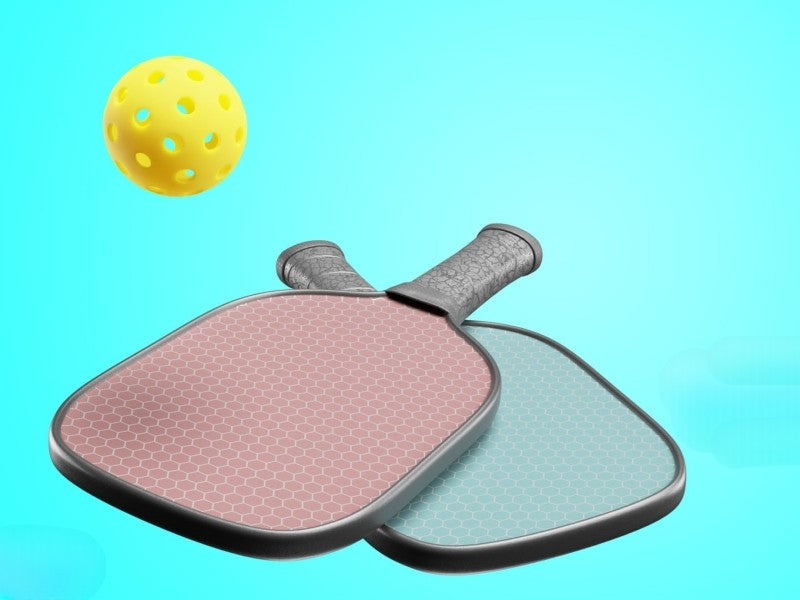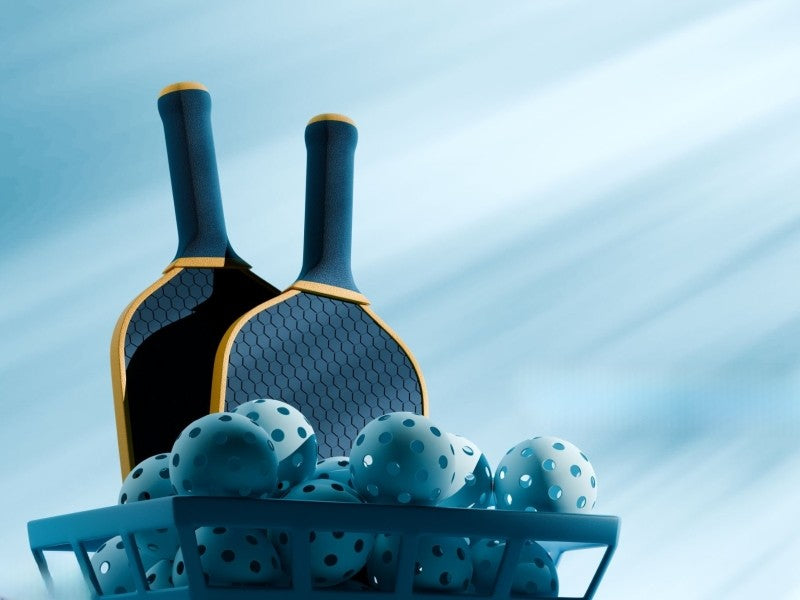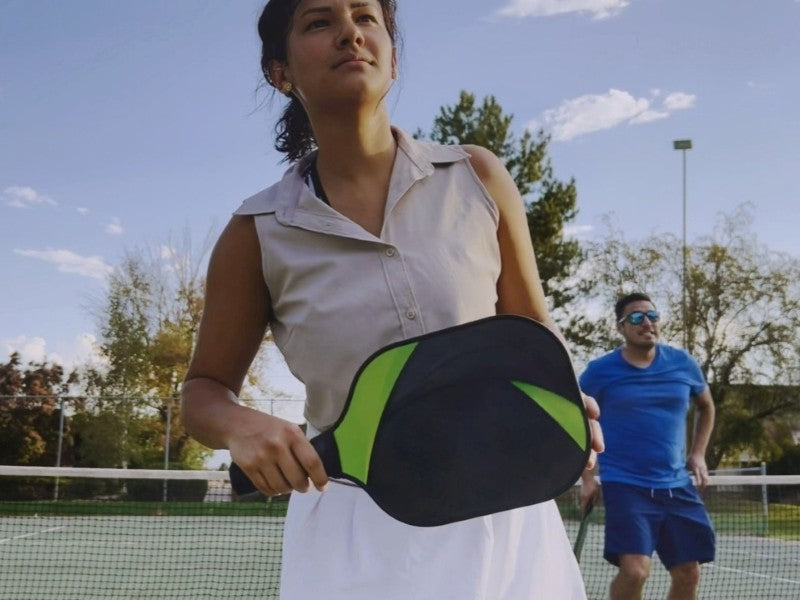Understanding the Key Components of a Pickleball Paddle
Before diving into technical details, it’s essential to recognize the key elements that make up any paddle:
· Face (Surface): The outer layer that contacts the ball. Determines power, spin, and feel.
· Core: The internal structure that defines how energy transfers on impact.
· Weight & Balance: Influence maneuverability, swing speed, and fatigue level.
· Shape & Grip: Affect sweet spot size, comfort, and wrist leverage.
· Texture: Impacts spin potential and ball contact time.
A “good” paddle isn’t simply the most expensive or the newest—it’s the one that aligns with your individual biomechanics and style.
1. The Face Material — The First Point of Contact
The paddle face is your main connection to the ball. Its composition largely dictates touch, control, spin, and durability. Let’s examine the most common materials and their distinct performance traits.
1.1 Carbon Fiber: Precision and Power
Carbon fiber paddles, such as those found in premium models from brands like SRIKEL, are known for their stiffness and responsiveness.
The tightly woven carbon layers create a rigid structure that efficiently transfers energy — meaning more power for aggressive drives with minimal energy loss.
Advantages:
· Excellent for experienced players who demand both power and precision.
· Highly durable and maintains performance longer under intense play.
· Generates a “crisp” contact feel with reduced vibration.
Potential Drawback:
Because carbon fiber is very stiff, beginners might feel less forgiveness on mishits compared to softer surfaces.
1.2 Fiberglass (Composite): Control and Forgiveness
Fiberglass, or composite faces, are often preferred by beginners and control-oriented players. The material flexes more on impact, offering better dwell time — the ball stays on the paddle a fraction longer, improving placement accuracy.
Advantages:
· Softer feel and excellent control for touch shots and dinks.
· Usually more affordable than carbon paddles.
· Ideal for players learning to manage ball placement.
Trade-off:
Fiberglass paddles tend to produce slightly less power and spin compared to high-grade carbon fiber options.
1.3 Hybrid or Graphite-Composite Faces
Some manufacturers now combine graphite and fiberglass layers to balance both qualities. Hybrid designs deliver carbon’s stiffness with fiberglass’s control, creating an all-around option suitable for diverse playing styles.
Example:
Certain models in SRIKEL’s lineup integrate a hybrid face construction — offering consistent responsiveness across the surface, helping players transition smoothly between power shots and soft net play.
1.4 Surface Texture and Spin Enhancement
Spin potential depends not only on the face material but also on surface treatment. Textured or roughened finishes, allowed within USAPA regulations, create micro-friction that helps grip the ball for enhanced topspin or slice.
Key takeaway:
For players who rely on spin to control rallies, a paddle with a slightly textured carbon surface provides a measurable advantage, without compromising on control.
2. The Core — The Engine Behind Every Shot
While the paddle face defines the first contact, the core determines how energy is distributed and absorbed. It’s the invisible force shaping the paddle’s balance between power, control, and comfort.
2.1 Polypropylene Honeycomb: The Modern Standard
Today, the majority of quality paddles use polypropylene (PP) honeycomb cores, prized for their light weight, durability, and balanced feel.
The honeycomb pattern disperses impact energy evenly, producing a stable and consistent rebound.
Benefits:
· Reduced vibration, making it easier on the wrist and elbow.
· Excellent balance of control and pop.
· Quiet play (a growing preference for many communities).
Ideal for: players seeking an all-purpose paddle with predictable response.
2.2 Nomex Honeycomb: High Power, Loud Pop
Nomex cores, made from resin-impregnated aramid paper, were among the first used in pickleball paddles. They are stiffer and louder, delivering extra power but less forgiveness.
Characteristics:
· Explosive energy return — ideal for strong hitters.
· Crisp, immediate feedback on contact.
· However, they can transmit more vibration and fatigue the arm over time.
Best for: advanced players prioritizing maximum drive speed and quick reaction shots.
2.3 Aluminum and Foam Cores: Control and Comfort
Although less common now, aluminum cores offer excellent control but can dent over time. Foam cores, on the other hand, are making a comeback in some high-end experimental paddles for their lightweight feel and shock absorption.
Foam-filled or hybrid honeycomb-foam cores may suit players recovering from arm strain or those seeking ultra-soft touch play.
2.4 Core Thickness and Its Impact
Core thickness directly affects both control and power:
|
Core Thickness |
Control Level |
Power Level |
Typical Use |
|
13mm |
Moderate control |
High power |
Offensive, fast gameplay |
|
14mm |
Balanced |
Balanced |
All-round performance |
|
16mm |
High control |
Moderate power |
Precision, defense, and net play |
In general, thicker cores (16mm) give more forgiveness and reduce vibration, while thinner cores provide a firmer, faster response.
3. Shape, Weight, and Balance — Engineering Meets Ergonomics
A paddle’s shape, overall mass, and weight distribution play a critical role in how it moves through the air and how your body feels after extended play. Let’s break these down.
3.1 Paddle Shape: The Blueprint of Performance
Common shapes include:
· Standard (16” x 8”): Balanced sweet spot, ideal for beginners and all-rounders.
· Elongated (16.5”+): Extra reach and power, favored by singles players.
· Wide-body (≤15.5”): Larger sweet spot, better for control and reaction volleys.
· Custom/teardrop shapes: Specialized for maneuverability and spin focus.
The right shape should match your play environment — wide-body paddles excel in fast doubles exchanges, while elongated ones give leverage for baseline drives.
3.2 Weight Classes and Their Effects
Pickleball paddles typically range from 7.0 oz to 8.5 oz, and this small variation can dramatically change your experience.
|
Weight Category |
Typical Range |
Pros |
Cons |
|
Lightweight |
7.0–7.5 oz |
Quick reactions, less fatigue |
Less driving power |
|
Midweight |
7.6–8.2 oz |
Balanced control & power |
Ideal for most players |
|
Heavyweight |
8.3 oz+ |
Maximum power & stability |
Can strain wrist/elbow |
· Lighter paddles favor control and speed, suitable for quick net exchanges.
· Heavier paddles generate more inertia and shot depth but require stronger wrists.
· Midweight paddles remain the most recommended starting point for versatility.
3.3 Balance Point: Head-Heavy vs. Even vs. Handle-Heavy
Balance refers to how the weight is distributed across the paddle.
· Head-heavy: Adds momentum for drives and smashes.
· Even balance: Offers a neutral swing feel and consistency.
· Handle-heavy: Enhances control, quicker resets, and wrist mobility.
Each player’s ideal balance depends on personal strength, reaction time, and game preference. Testing different balances can often reveal surprising improvements in comfort and precision.
3.4 Grip Size and Handle Comfort
Finally, grip diameter and length determine how comfortably and accurately you can maneuver the paddle.
A grip that’s too thick reduces wrist motion, while one too thin causes instability.
Quick tip:
Wrap your hand around the grip — if your index finger fits snugly between your fingertips and palm, the size is correct.
Proper grip sizing also minimizes vibration transmission, lowering the risk of tennis elbow or wrist strain.
4. Performance Testing — Turning Feel into Measurable Results
Even the best technical specs don’t always tell the whole story. Two paddles may look identical on paper but feel completely different in hand. That’s why good players rely on performance testing — a combination of measurable data and real-world feedback — to determine what truly works.
4.1 Core Performance Metrics
To understand how a paddle performs, we can focus on a few quantifiable parameters:
|
Metric |
What It Measures |
Why It Matters |
|
Ball Speed (Drive Velocity) |
How fast the ball leaves the paddle |
Indicates raw power potential |
|
Rebound Coefficient (COR) |
Ratio of rebound to impact energy |
Reflects efficiency and responsiveness |
|
Sweet Spot Coverage |
Area of consistent rebound |
Larger sweet spot = more forgiveness |
|
Spin Rate (RPM) |
Ball rotation after impact |
Affects control and shot depth |
|
Vibration Damping |
Paddle’s ability to absorb shock |
Reduces arm fatigue and injuries |
Modern test setups — such as using radar guns, slow-motion cameras, or even smartphone accelerometers — can help players analyze these variables. While not every player has access to lab tools, controlled field tests provide valuable insight.
4.2 How to Test Your Paddle Like a Pro
You can conduct a simple yet effective evaluation using this five-minute field protocol:
1. Drive Test: Hit five baseline drives at full power and measure consistency of depth.
2. Dink Precision: Perform 20 dinks close to the net. Count how many land within target zones.
3. Spin Challenge: Apply topspin and slice; observe ball curvature and bounce reaction.
4. Reaction Time Drill: Block volleys rapidly to gauge paddle maneuverability.
5. Comfort Check: After 15 minutes, note wrist or elbow fatigue level.
Record your impressions in a small notebook or spreadsheet — these metrics reveal patterns over time, helping you fine-tune paddle choice beyond brand claims.
4.3 Reading the Results
A good paddle should deliver:
· Consistent depth and rebound across different impact zones.
· Predictable spin control without excessive vibration.
· Comfort during extended play, especially at the wrist and elbow.
· Stable handling under both offensive and defensive shots.
When a paddle performs evenly across these categories, you’ve likely found an optimal fit.

5. Choosing the Right Paddle for Your Playing Style
Different players value different attributes. Instead of chasing a “perfect” paddle, match your paddle’s behavior to your style and physical strength.
5.1 For Beginners: Focus on Forgiveness and Comfort
New players benefit from larger sweet spots and lighter paddles (7.3–7.6 oz).
· Material: Fiberglass or hybrid face for softer touch.
· Core: 16 mm polypropylene honeycomb for vibration reduction.
· Shape: Wide-body for easier contact.
· Goal: Build confidence in ball control before chasing power.
5.2 For All-Round Players: Balance Power and Control
Intermediate players need a paddle that reacts well in both offense and defense.
· Material: Carbon-fiberglass blend or textured graphite face.
· Core: 14–15 mm for balance.
· Weight: Midweight (7.8–8.2 oz).
· Example: Several SRIKEL models use hybrid carbon-fiber faces paired with 14 mm honeycomb cores, achieving the balanced pop-and-control ratio ideal for versatile play.
5.3 For Power Players: Harness Speed and Momentum
Aggressive baseliners and singles players often prefer head-heavy, stiffer paddles.
· Material: Full carbon fiber for explosive drives.
· Core: 13–14 mm Nomex or high-density polypropylene.
· Shape: Elongated for reach and leverage.
· Trade-off: More power but requires precise timing.
5.4 For Control Players: Precision and Touch
Defensive or net-dominated players rely on precision.
· Material: Fiberglass or carbon-foam hybrid face.
· Core: 16 mm+ for stability and damping.
· Weight: Slightly lighter for easier resets.
· Note: A textured surface helps with controlled spin in soft exchanges.
5.5 For Seniors or Players with Arm Sensitivity
Comfort and joint safety become key.
· Material: Flexible composite surface.
· Core: Thick polypropylene honeycomb or foam core.
· Grip: Slightly larger, cushioned handles to absorb shock.
· Tip: Avoid overly head-heavy paddles; balance equals endurance.
6. Maintenance and Care — Extending Paddle Lifespan
Even top-quality paddles degrade over time. Regular care not only maintains performance but also prevents injuries caused by unpredictable rebound or vibration.
6.1 Cleaning and Storage
· Wipe the paddle face with a soft microfiber cloth after each use to remove dirt and oils.
· Avoid chemical cleaners; mild soap and water are sufficient.
· Store paddles flat and away from direct heat or humidity — extreme conditions weaken bonding layers.
6.2 Handle and Grip Maintenance
· Replace grip wraps every few months to prevent slippage.
· Use overgrips for sweat absorption and consistent thickness.
· Check for any looseness at the junction between handle and face — early repair prevents delamination.
6.3 Edge Guard and Surface Care
· Inspect edge guards regularly; a lifted edge can trap moisture.
· If your paddle has surface texture, clean gently to preserve friction pattern integrity.
6.4 When to Replace Your Paddle
Signs your paddle is losing efficiency:
· Noticeable dead spots or reduced pop.
· Excess vibration after shots.
· Surface peeling or softening of the core sound.
On average, recreational players replace paddles every 1–2 years; competitive players may need yearly refreshes.
7. Frequently Asked Questions (FAQ)
Q1: Does paddle weight really make a big difference?
Yes. Even a 0.3 oz difference changes swing speed and shot stability. Lightweight paddles increase agility, while heavier paddles add driving power.
Q2: Are textured paddles legal?
Yes, as long as the surface roughness meets USAPA standards (≤ 40 microns). All mainstream brands like SRIKEL design within those limits.
Q3: What’s better — graphite or fiberglass?
Graphite (carbon) is stiffer and powerful; fiberglass offers more dwell time and touch. Choose based on whether you prioritize speed or control.
Q4: Does paddle thickness affect spin?
Indirectly. Thicker cores enhance control but reduce trampoline effect; spin mainly depends on surface texture and player technique.
Q5: Can I use the same paddle indoors and outdoors?
You can, but note that outdoor balls are heavier and faster. Some players keep separate paddles — softer for indoors, stiffer for outdoors.
Q6: How can I reduce elbow strain?
Use a thicker, softer-core paddle with good damping, avoid head-heavy designs, and maintain proper grip technique.
Q7: How do I know if my paddle is “too advanced” for me?
If you frequently mishit, feel excessive vibration, or struggle with control, the paddle may have too small a sweet spot or be too stiff for your level.









Leave a comment
This site is protected by hCaptcha and the hCaptcha Privacy Policy and Terms of Service apply.